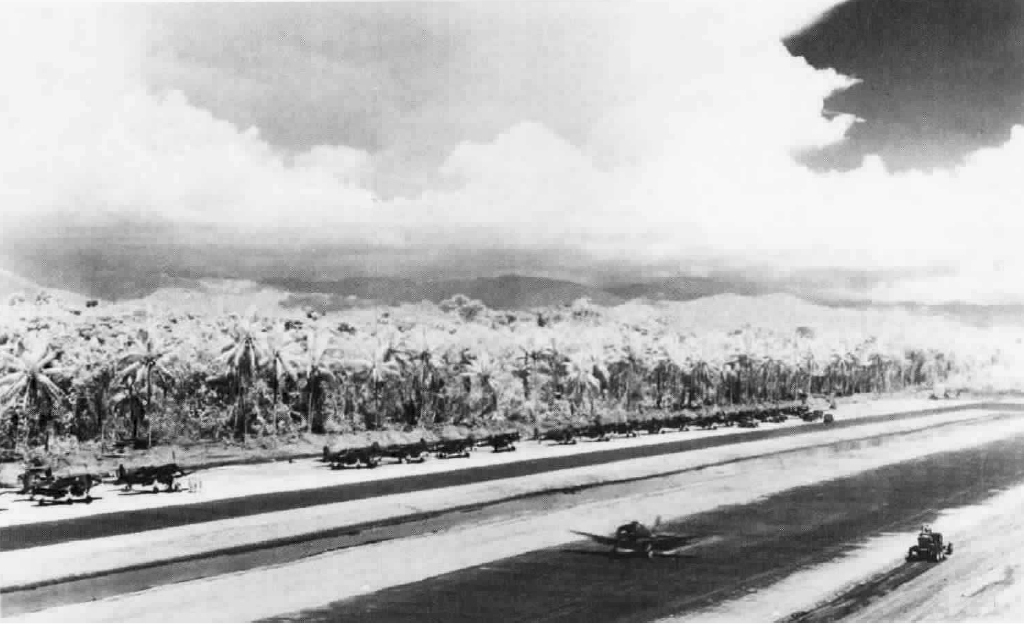Torokina Airfield on:
[Wikipedia]
[Google]
[Amazon]
Torokina Airfield, also known as Cape Torokina Airfield, is a former
 *United States Navy
: VC-40 operating
*United States Navy
: VC-40 operating
Torokina Airfield
Airfields of the United States Army Air Forces in the South West Pacific theatre of World War II Seabees World War II sites in Papua New Guinea
World War II
World War II or the Second World War, often abbreviated as WWII or WW2, was a world war that lasted from 1939 to 1945. It involved the vast majority of the world's countries—including all of the great powers—forming two opposing ...
airfield located at Cape Torokina Cape Torokina is a promontory at the north end of Empress Augusta Bay, along the central part of the western coast of Bougainville, in Papua New Guinea.
This cape formed the southern end of the landing zone where I Marine Amphibious Corps perfor ...
, Bougainville.
History
World War II
The3rd Marine Division
The 3rd Marine Division is a division of the United States Marine Corps based at Camp Courtney, Marine Corps Base Camp Smedley D. Butler in Okinawa, Japan. It is one of three active duty infantry divisions in the Marine Corps and together with th ...
landed on Bougainville on 1 November 1943 at the start of the Bougainville Campaign
The Bougainville campaign was a series of land and naval battles of the Pacific campaign of World War II between Allied forces and the Empire of Japan, named after the island of Bougainville. It was part of Operation Cartwheel, the Allie ...
, establishing a beachhead around Cape Torokina. Small detachments of the 25th, 53rd, 71st and 75th Naval Construction Battalions landed with the Marines and the 71st Battalion was tasked with establishing a by fighter airfield that would become Torokina Airfield. The airfield became operational on December 10, 1943 when VMF-216
Marine Fighting Squadron 216 (VMF-216) was a reserve fighter squadron of the United States Marine Corps that was based out of Washington. Known as the “Bulldogs”, VMF-216 participated in numerous combat engagements in the Pacific Theater du ...
landed with 18 F4U Corsair
The Vought F4U Corsair is an American fighter aircraft which saw service primarily in World War II and the Korean War. Designed and initially manufactured by Chance Vought, the Corsair was soon in great demand; additional production contracts ...
s.
On 9 March 1944, the Japanese shelled the airfield and forced the squadrons that were based there to take off to avoid damage to their aircraft. Royal New Zealand Air Force squadrons also began operating from the airfield from January 1, 1944. Units assigned to the airfield included:
 *United States Navy
: VC-40 operating
*United States Navy
: VC-40 operating Grumman TBF Avenger
The Grumman TBF Avenger (designated TBM for aircraft manufactured by General Motors) is an American World War II-era torpedo bomber developed initially for the United States Navy and Marine Corps, and eventually used by several air and naval a ...
s
: ACORN 13
: VF(N)-75 operating Vought F4U Corsair
The Vought F4U Corsair is an American fighter aircraft which saw service primarily in World War II and the Korean War. Designed and initially manufactured by Chance Vought, the Corsair was soon in great demand; additional production contract ...
s
*VF-17 with Corsair
*United States Marine Corps
: VMTB-233 operating TBF Avengers
:VMF-211
Marine Fighter Attack Squadron 211 (VMFA-211) is a United States Marine Corps fighter attack squadron, currently consisting of F-35B Lightning II stealth STOVL strike fighter jets. Known as the "Wake Island Avengers" and the "Bastion Defenders", ...
operating F4U Corsairs
:VMF-212
Marine Fighter Attack Squadron 212 (VMFA-212) was a United States Marine Corps F/A-18 Hornet squadron. Most recently known as the "Lancers", the squadron was last based at Marine Corps Air Station Iwakuni, Japan and fell under the command of Mar ...
operating F4U Corsairs
: VMF-215 operating F4U Corsairs
:VMF-216
Marine Fighting Squadron 216 (VMF-216) was a reserve fighter squadron of the United States Marine Corps that was based out of Washington. Known as the “Bulldogs”, VMF-216 participated in numerous combat engagements in the Pacific Theater du ...
operating F4U Corsairs
: VMF(N)-531 operating Lockheed PV-1 Ventura night-fighters
*Royal New Zealand Air Force
: No. 19 Squadron operating F4U Corsairs
Postwar
Today the airfield is no longer used and most of the runway is overgrown with vegetation.See also
* Piva Airfield *United States Army Air Forces in the South Pacific Area
During World War II, the United States Army Air Forces engaged in combat against the Empire of Japan in the South Pacific Area. As defined by the War Department, this consisted of the Pacific Ocean areas which lay south of the Equator between l ...
References
{{Air Force Historical Research AgencyExternal links
Torokina Airfield
Airfields of the United States Army Air Forces in the South West Pacific theatre of World War II Seabees World War II sites in Papua New Guinea